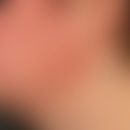DefinitionThis section has been translated automatically.
Free preauricular full-thickness skin graft consisting of epidermis and the entire corium.
General informationThis section has been translated automatically.
- The donor region for a full-thickness flap harvest should be as similar as possible to the defect area to be covered.
- For defects after tumor excision in the area of cartilage- or bone-supported tissue, e.g. nose, auricle, a praeauricularly removed transplant is particularly suitable. The tumour is excised circular or oval except for the perichondrium or periosteum. The excidate should be applied to the 3-D histological "flounder technique" developed by Breuninger and Holzschuh to ensure complete control of a complete tumour removal. The temporary covering of the defect area is done with a synthetic skin replacement. After histologically confirmed complete removal of the lesion, an elliptical, spindle-shaped or sublobular relief triangle-shaped preauricular graft is performed in the non-hairy donor area in front of the tragus, depending on its size. The subcutaneous fatty tissue is prepared from the underside of the graft on a moist saline compress as a base using fine curved and pointed scissors. The removed full skin is then cut with a scalpel so that it covers about 80% of the defect size.
- The transplant is sutured in using Allgöwer backstitch sutures. The knot is always located at the opposite edge of the wound. The use of compresses is unnecessary. This would make it more difficult to check the graft during the first critical days of healing (haematoma, seroma, infection with graft detachment! A first dressing change should take place about 24 hours after the operation. On the fourth postoperative day every second, after 6 days the remaining stitches are removed.
-
Notice!
A frequently observed livid red discoloration of the full-thickness flap during the first postoperative days is a sign of successful healing. Between the fifth and eighth postoperative day a transplant autolysis is often present, which leads to the formation of a dark crust and could be misinterpreted as total necrosis. Through superficial scalpel incisions, for example, an autolysis associated with blister formation can be drained. If a hematoma appears under the graft on the first day after the procedure, it should be expressed by gentle pressure with the swab. - Indications: nose (fig.1 a-e, fig. 2 a-d, fig. 3 a-c), auricle (fig. 4a-c), inner corner of the eye, temple.
Notice! It is possible to suture two or three pre and/or retroauricularly removed full-thickness skin lobes together.
Complication(s)This section has been translated automatically.
As a late complication, tissue shrinkage, hypertrophic scars or keloids rarely occur with full skin transplants. Hyper- or hypopigmentation is prevented by prophylactic sun protection.
LiteratureThis section has been translated automatically.
- Adnot J, Salasche SJ (1987) Visualized basting sutures in the application of fullthickness skin grafts. J Dermatol Surg Oncol 13: 1236-1239
- Breuninger H, wooden shoe J (1994) The complete histological presentation of the cut edges of a skin tumor excise (3-D histology) in one sectional plane using the "flounder technique". Nude Dermatol 20: 7-10
- Salasche SJ, Feldman BD (1987) Skin grafting: preoperative technique and management. J Dermatol Surg Oncol 13: 973-978
- Schulz H (1988) Operative dermatology of the face. Practical interventions. Diesbach, Berlin
- Schulz H, Altmeyer P, Stücker M, Hoffmann K (1997) Outpatient operations in dermatology. Hippocrates, Stuttgart



















